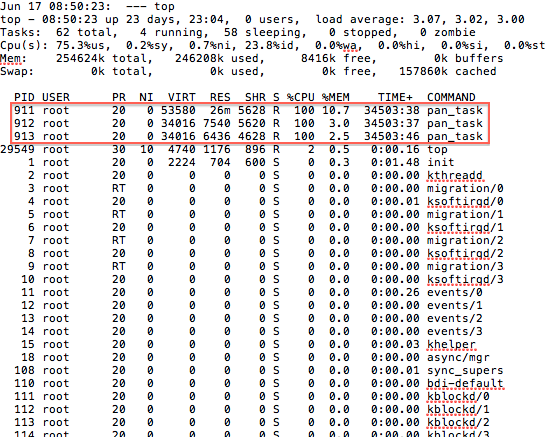- Access exclusive content
- Connect with peers
- Share your expertise
- Find support resources
Click Preferences to customize your cookie settings.
Unlock your full community experience!
About process pan_task of dp-monitor.log
- LIVEcommunity
- Discussions
- General Topics
- About process pan_task of dp-monitor.log
- Subscribe to RSS Feed
- Mark Topic as New
- Mark Topic as Read
- Float this Topic for Current User
- Printer Friendly Page
- Mark as New
- Subscribe to RSS Feed
- Permalink
06-25-2013 09:51 AM
Hello,
I have a question about the process "pan_task" of dp-monitor.log, it always shown high cpu usage.
Any one can tell me what the mean is ?
Thanks.

- Labels:
-
Troubleshooting
Accepted Solutions
- Mark as New
- Subscribe to RSS Feed
- Permalink
06-25-2013 11:04 AM
The CPU output from the TOP command can not be used to determine dataplane load. The pan_task processes are always at 100% CPU utilization as they are the individual software processes which perform packet processing on the dataplane.
As others have stated, you should use output from "show running resource-monitor" on the CLI to determine the true dataplane load. This command is also run and logged to the dp-monitor.log files on the dataplane so you can look at historical utilization as well. In the output from this command on a 2050 you will see 4 individual cores listed, 0-3. The pan_task processes shown in the top output correspond to cores 1-3 listed in this output. On other platforms you will find a pan_task process is running for each core beyond core 0.
- Mark as New
- Subscribe to RSS Feed
- Permalink
06-25-2013 09:59 AM
Hello,
The Pan_task are the threads in the dataplane, where the packets are processed , and they would always show values like 99% or 100%. It is a legitimate value and means that the dataplane is busy processing all the packets that it receives.
Best regards,
Karthik RP
- Mark as New
- Subscribe to RSS Feed
- Permalink
06-25-2013 10:00 AM
To know the actual dataplane load, you can use the command:
> show running resource-monitor
Best regards,
Karthik RP
- Mark as New
- Subscribe to RSS Feed
- Permalink
06-25-2013 10:04 AM
Hello,
My device is PA2050 which runs PanOS 4.1.12.
Thanks.
- Mark as New
- Subscribe to RSS Feed
- Permalink
06-25-2013 10:08 AM
I can see a similar output even in on of lab devices:
Jun 24 18:30:35: --- top
top - 18:30:35 up 24 days, 7:21, 0 users, load average: 3.00, 3.00, 3.00
Tasks: 62 total, 4 running, 58 sleeping, 0 stopped, 0 zombie
Cpu(s): 75.2%us, 0.1%sy, 0.4%ni, 24.0%id, 0.3%wa, 0.0%hi, 0.0%si, 0.0%st
Mem: 254608k total, 238780k used, 15828k free, 0k buffers
Swap: 0k total, 0k used, 0k free, 136968k cached
PID USER PR NI VIRT RES SHR S %CPU %MEM TIME+ COMMAND
862 root 20 0 49032 25m 5108 R 100 10.3 35001:16 pan_task
863 root 20 0 29468 6588 5080 R 100 2.6 35001:14 pan_task
864 root 20 0 29468 5744 4260 R 100 2.3 35001:17 pan_task
29656 root 30 10 4740 1176 896 R 2 0.5 0:00.10 top
- Mark as New
- Subscribe to RSS Feed
- Permalink
06-25-2013 10:09 AM
what is your output on running-resource monitor
- Mark as New
- Subscribe to RSS Feed
- Permalink
06-25-2013 11:04 AM
The CPU output from the TOP command can not be used to determine dataplane load. The pan_task processes are always at 100% CPU utilization as they are the individual software processes which perform packet processing on the dataplane.
As others have stated, you should use output from "show running resource-monitor" on the CLI to determine the true dataplane load. This command is also run and logged to the dp-monitor.log files on the dataplane so you can look at historical utilization as well. In the output from this command on a 2050 you will see 4 individual cores listed, 0-3. The pan_task processes shown in the top output correspond to cores 1-3 listed in this output. On other platforms you will find a pan_task process is running for each core beyond core 0.
- 1 accepted solution
- 21117 Views
- 6 replies
- 0 Likes
Show your appreciation!
Click Accept as Solution to acknowledge that the answer to your question has been provided.
The button appears next to the replies on topics you’ve started. The member who gave the solution and all future visitors to this topic will appreciate it!
These simple actions take just seconds of your time, but go a long way in showing appreciation for community members and the LIVEcommunity as a whole!
The LIVEcommunity thanks you for your participation!
- GRPC status UNAVAILABLE in intelligent offload in VM-Series in the Private Cloud
- One BIOC with OR for Process name and CMD in Cortex XDR Discussions
- identify for MS Office processes that write an executable file with BIOC or XQL in Cortex XDR Discussions
- Use case BIOC Creation in Cortex XSIAM Discussions
- Activate ECMP without trafic disruption in Next-Generation Firewall Discussions



